An Analysis of Key Strategy Development Tools in Business - HI6006
VerifiedAdded on 2022/11/29
|12
|2928
|194
Essay
AI Summary
This essay provides an in-depth analysis of key strategy development tools used in business. It explores four core models: Porter's Five Forces, SWOT analysis, PESTEL analysis, and Input-Output model, detailing their applications and significance. The essay explains each tool, its components, and how it aids in strategic planning and decision-making. It examines the competitive landscape, internal and external factors, and their influence on business operations. Practical examples and references to academic journals are included to illustrate the real-world application of these tools. The essay emphasizes how these tools help businesses understand their environment, identify opportunities, mitigate threats, and achieve a competitive advantage, including the benefits of each tool in improving business operations. The analysis also highlights the importance of strategic management and its continuous, collaborative nature in adapting to dynamic market conditions. This resource is available on Desklib to aid students in their studies.
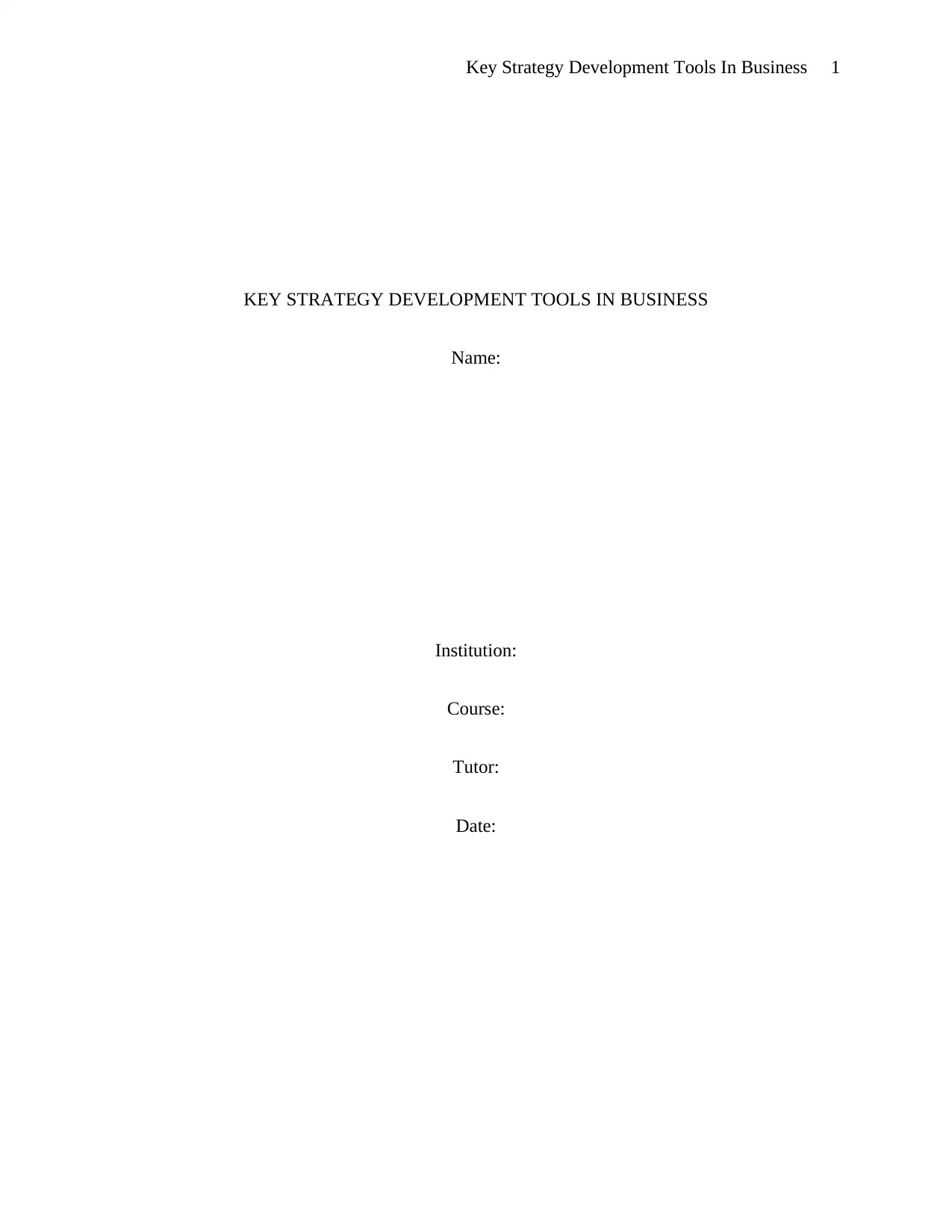
Key Strategy Development Tools In Business 1
KEY STRATEGY DEVELOPMENT TOOLS IN BUSINESS
Name:
Institution:
Course:
Tutor:
Date:
KEY STRATEGY DEVELOPMENT TOOLS IN BUSINESS
Name:
Institution:
Course:
Tutor:
Date:
Paraphrase This Document
Need a fresh take? Get an instant paraphrase of this document with our AI Paraphraser

Key Strategy Development Tools In Business 2
Abstract
The need to have a strategic management tool enables most organizations to review their
present processes as well as to make intentional decisions concerning the directions of their
operations. Most managers in businesses do not completely understand targets behind strategic
management or why it needs to be implemented in their operational settings. A thorough
understanding of the function of strategic management can be significant as it can help different
organizations to gain a competitive edge within their operations. The review of literature that
support strategic management devices such as SWOT analysis, PESTEL analysis, Porter’s five
forces, Input or Output analysis, Competitive Advantage, and Balanced Scorecard offer a
comprehensive focus at techniques engineering by different surveyors to aid corporation
directors move their organizations ahead of the rival and sustain the competitive merit in the
international marketplaces. Besides, this review also examines the synthesis of strategic
management to illustrate organizational leaders the differences when comparing one device to
another that facilitates the determination of the best device to fit the needs of the organization.
Strategic management devices
The international increase markets have changed dramatically over the past few years.
The advancement in the industrial era has brought nationalization as various business operations
began to progress from being situated in a single city or nation to positioning their operations
across lines of states and into different sections of the country (Wurthmann 2019). The need to
have an effective plan in various business operations of organizations in business society remains
to be the essential aspect of each company in the competitive markets. Strategic development
devices are vital as they aid businesses to have the appropriate understanding of the business
Abstract
The need to have a strategic management tool enables most organizations to review their
present processes as well as to make intentional decisions concerning the directions of their
operations. Most managers in businesses do not completely understand targets behind strategic
management or why it needs to be implemented in their operational settings. A thorough
understanding of the function of strategic management can be significant as it can help different
organizations to gain a competitive edge within their operations. The review of literature that
support strategic management devices such as SWOT analysis, PESTEL analysis, Porter’s five
forces, Input or Output analysis, Competitive Advantage, and Balanced Scorecard offer a
comprehensive focus at techniques engineering by different surveyors to aid corporation
directors move their organizations ahead of the rival and sustain the competitive merit in the
international marketplaces. Besides, this review also examines the synthesis of strategic
management to illustrate organizational leaders the differences when comparing one device to
another that facilitates the determination of the best device to fit the needs of the organization.
Strategic management devices
The international increase markets have changed dramatically over the past few years.
The advancement in the industrial era has brought nationalization as various business operations
began to progress from being situated in a single city or nation to positioning their operations
across lines of states and into different sections of the country (Wurthmann 2019). The need to
have an effective plan in various business operations of organizations in business society remains
to be the essential aspect of each company in the competitive markets. Strategic development
devices are vital as they aid businesses to have the appropriate understanding of the business
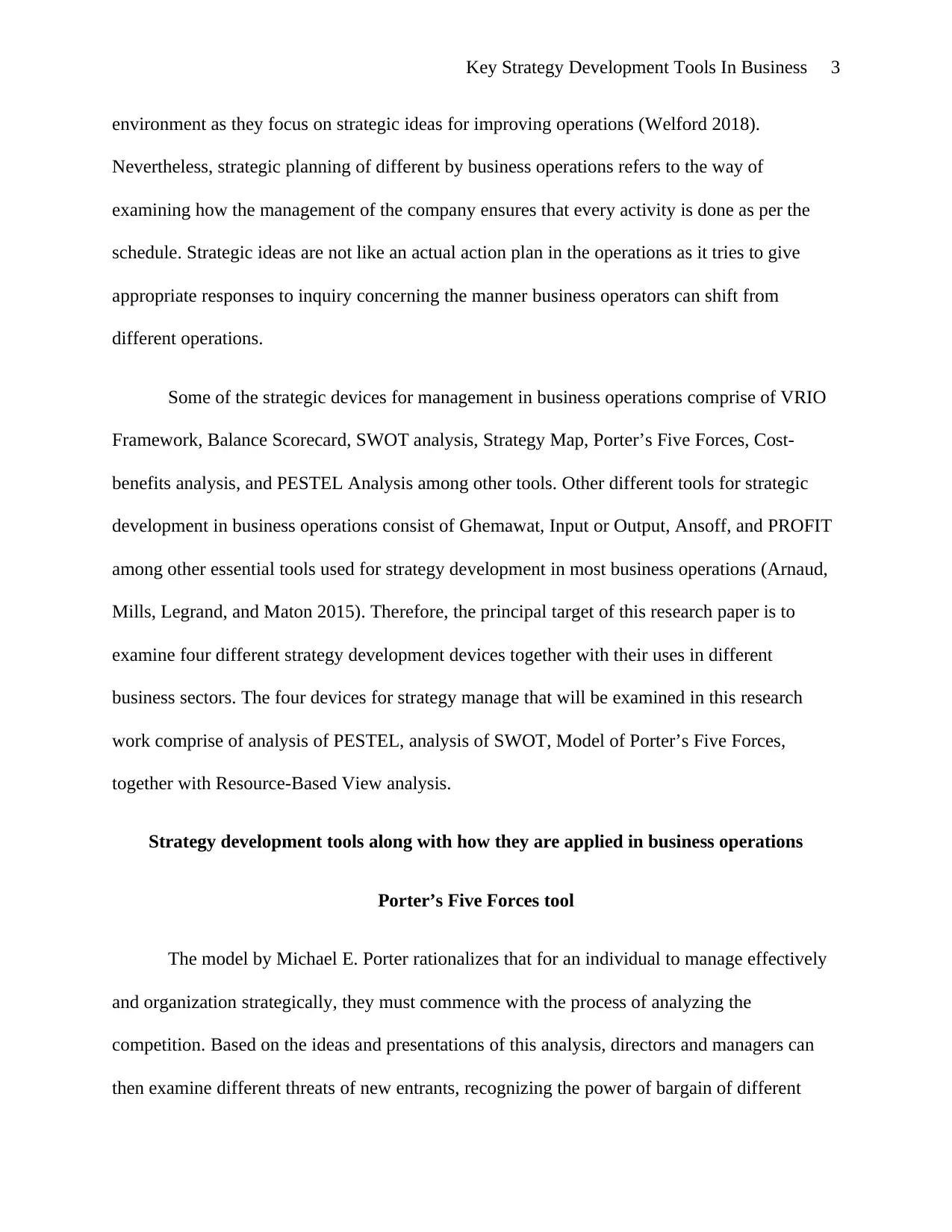
Key Strategy Development Tools In Business 3
environment as they focus on strategic ideas for improving operations (Welford 2018).
Nevertheless, strategic planning of different by business operations refers to the way of
examining how the management of the company ensures that every activity is done as per the
schedule. Strategic ideas are not like an actual action plan in the operations as it tries to give
appropriate responses to inquiry concerning the manner business operators can shift from
different operations.
Some of the strategic devices for management in business operations comprise of VRIO
Framework, Balance Scorecard, SWOT analysis, Strategy Map, Porter’s Five Forces, Cost-
benefits analysis, and PESTEL Analysis among other tools. Other different tools for strategic
development in business operations consist of Ghemawat, Input or Output, Ansoff, and PROFIT
among other essential tools used for strategy development in most business operations (Arnaud,
Mills, Legrand, and Maton 2015). Therefore, the principal target of this research paper is to
examine four different strategy development devices together with their uses in different
business sectors. The four devices for strategy manage that will be examined in this research
work comprise of analysis of PESTEL, analysis of SWOT, Model of Porter’s Five Forces,
together with Resource-Based View analysis.
Strategy development tools along with how they are applied in business operations
Porter’s Five Forces tool
The model by Michael E. Porter rationalizes that for an individual to manage effectively
and organization strategically, they must commence with the process of analyzing the
competition. Based on the ideas and presentations of this analysis, directors and managers can
then examine different threats of new entrants, recognizing the power of bargain of different
environment as they focus on strategic ideas for improving operations (Welford 2018).
Nevertheless, strategic planning of different by business operations refers to the way of
examining how the management of the company ensures that every activity is done as per the
schedule. Strategic ideas are not like an actual action plan in the operations as it tries to give
appropriate responses to inquiry concerning the manner business operators can shift from
different operations.
Some of the strategic devices for management in business operations comprise of VRIO
Framework, Balance Scorecard, SWOT analysis, Strategy Map, Porter’s Five Forces, Cost-
benefits analysis, and PESTEL Analysis among other tools. Other different tools for strategic
development in business operations consist of Ghemawat, Input or Output, Ansoff, and PROFIT
among other essential tools used for strategy development in most business operations (Arnaud,
Mills, Legrand, and Maton 2015). Therefore, the principal target of this research paper is to
examine four different strategy development devices together with their uses in different
business sectors. The four devices for strategy manage that will be examined in this research
work comprise of analysis of PESTEL, analysis of SWOT, Model of Porter’s Five Forces,
together with Resource-Based View analysis.
Strategy development tools along with how they are applied in business operations
Porter’s Five Forces tool
The model by Michael E. Porter rationalizes that for an individual to manage effectively
and organization strategically, they must commence with the process of analyzing the
competition. Based on the ideas and presentations of this analysis, directors and managers can
then examine different threats of new entrants, recognizing the power of bargain of different
⊘ This is a preview!⊘
Do you want full access?
Subscribe today to unlock all pages.

Trusted by 1+ million students worldwide
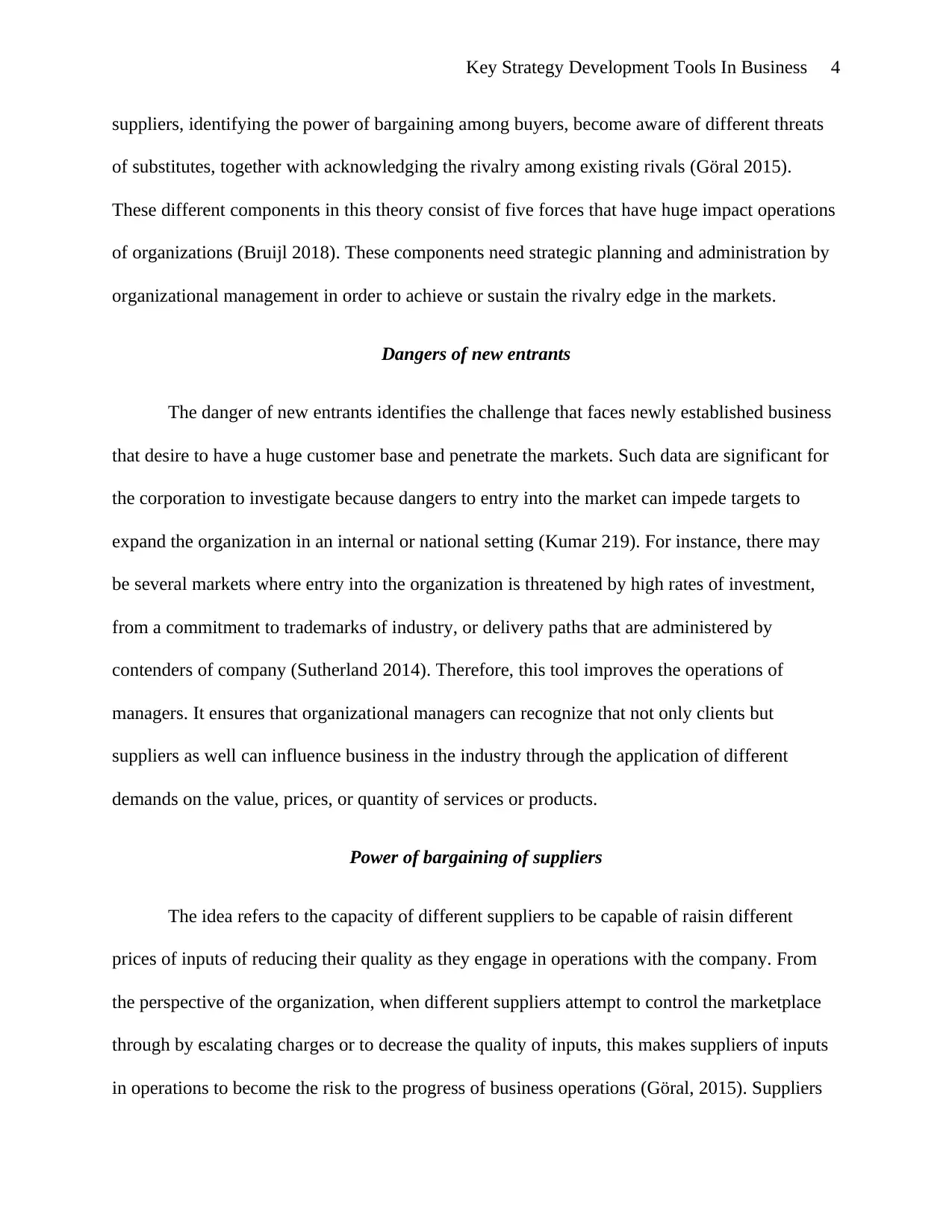
Key Strategy Development Tools In Business 4
suppliers, identifying the power of bargaining among buyers, become aware of different threats
of substitutes, together with acknowledging the rivalry among existing rivals (Göral 2015).
These different components in this theory consist of five forces that have huge impact operations
of organizations (Bruijl 2018). These components need strategic planning and administration by
organizational management in order to achieve or sustain the rivalry edge in the markets.
Dangers of new entrants
The danger of new entrants identifies the challenge that faces newly established business
that desire to have a huge customer base and penetrate the markets. Such data are significant for
the corporation to investigate because dangers to entry into the market can impede targets to
expand the organization in an internal or national setting (Kumar 219). For instance, there may
be several markets where entry into the organization is threatened by high rates of investment,
from a commitment to trademarks of industry, or delivery paths that are administered by
contenders of company (Sutherland 2014). Therefore, this tool improves the operations of
managers. It ensures that organizational managers can recognize that not only clients but
suppliers as well can influence business in the industry through the application of different
demands on the value, prices, or quantity of services or products.
Power of bargaining of suppliers
The idea refers to the capacity of different suppliers to be capable of raisin different
prices of inputs of reducing their quality as they engage in operations with the company. From
the perspective of the organization, when different suppliers attempt to control the marketplace
through by escalating charges or to decrease the quality of inputs, this makes suppliers of inputs
in operations to become the risk to the progress of business operations (Göral, 2015). Suppliers
suppliers, identifying the power of bargaining among buyers, become aware of different threats
of substitutes, together with acknowledging the rivalry among existing rivals (Göral 2015).
These different components in this theory consist of five forces that have huge impact operations
of organizations (Bruijl 2018). These components need strategic planning and administration by
organizational management in order to achieve or sustain the rivalry edge in the markets.
Dangers of new entrants
The danger of new entrants identifies the challenge that faces newly established business
that desire to have a huge customer base and penetrate the markets. Such data are significant for
the corporation to investigate because dangers to entry into the market can impede targets to
expand the organization in an internal or national setting (Kumar 219). For instance, there may
be several markets where entry into the organization is threatened by high rates of investment,
from a commitment to trademarks of industry, or delivery paths that are administered by
contenders of company (Sutherland 2014). Therefore, this tool improves the operations of
managers. It ensures that organizational managers can recognize that not only clients but
suppliers as well can influence business in the industry through the application of different
demands on the value, prices, or quantity of services or products.
Power of bargaining of suppliers
The idea refers to the capacity of different suppliers to be capable of raisin different
prices of inputs of reducing their quality as they engage in operations with the company. From
the perspective of the organization, when different suppliers attempt to control the marketplace
through by escalating charges or to decrease the quality of inputs, this makes suppliers of inputs
in operations to become the risk to the progress of business operations (Göral, 2015). Suppliers
Paraphrase This Document
Need a fresh take? Get an instant paraphrase of this document with our AI Paraphraser
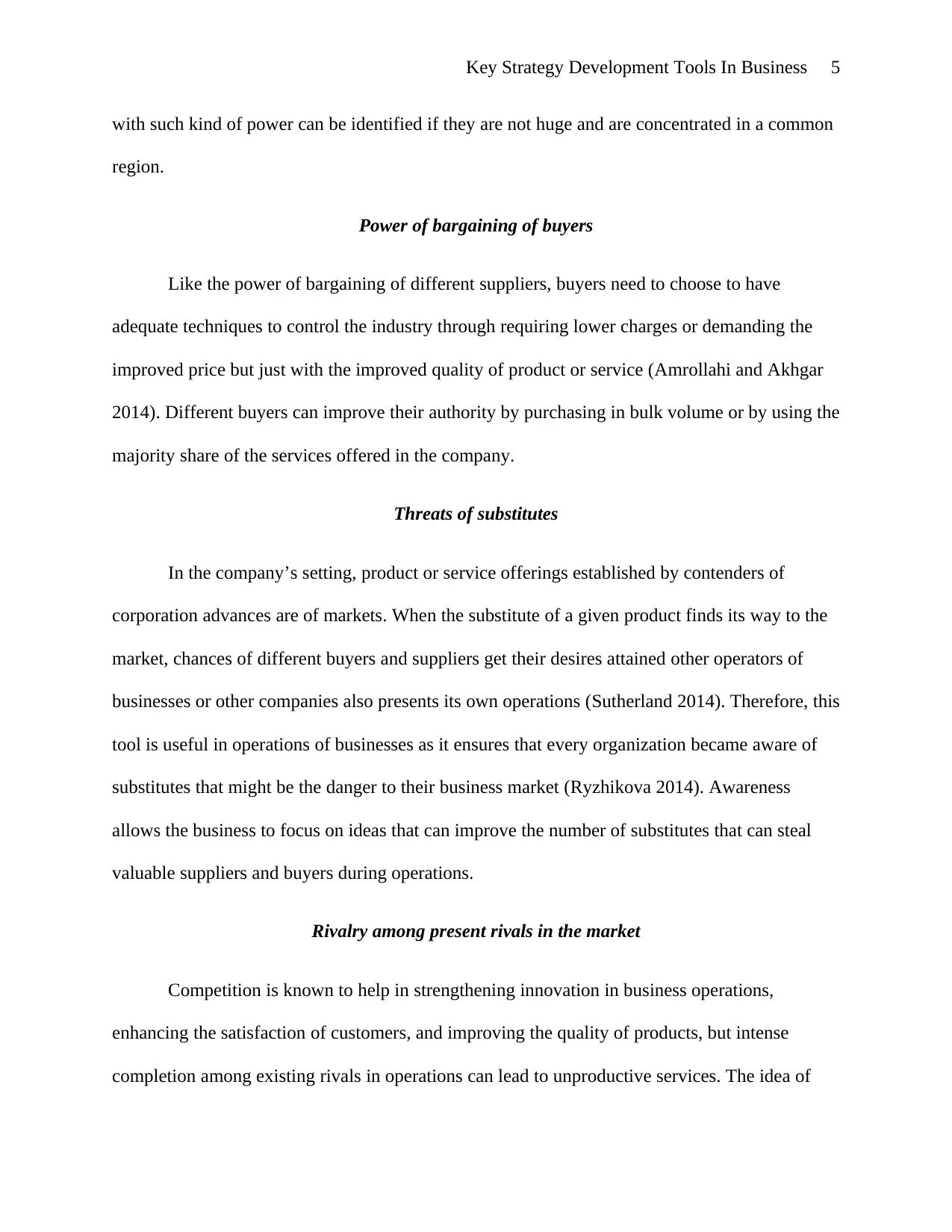
Key Strategy Development Tools In Business 5
with such kind of power can be identified if they are not huge and are concentrated in a common
region.
Power of bargaining of buyers
Like the power of bargaining of different suppliers, buyers need to choose to have
adequate techniques to control the industry through requiring lower charges or demanding the
improved price but just with the improved quality of product or service (Amrollahi and Akhgar
2014). Different buyers can improve their authority by purchasing in bulk volume or by using the
majority share of the services offered in the company.
Threats of substitutes
In the company’s setting, product or service offerings established by contenders of
corporation advances are of markets. When the substitute of a given product finds its way to the
market, chances of different buyers and suppliers get their desires attained other operators of
businesses or other companies also presents its own operations (Sutherland 2014). Therefore, this
tool is useful in operations of businesses as it ensures that every organization became aware of
substitutes that might be the danger to their business market (Ryzhikova 2014). Awareness
allows the business to focus on ideas that can improve the number of substitutes that can steal
valuable suppliers and buyers during operations.
Rivalry among present rivals in the market
Competition is known to help in strengthening innovation in business operations,
enhancing the satisfaction of customers, and improving the quality of products, but intense
completion among existing rivals in operations can lead to unproductive services. The idea of
with such kind of power can be identified if they are not huge and are concentrated in a common
region.
Power of bargaining of buyers
Like the power of bargaining of different suppliers, buyers need to choose to have
adequate techniques to control the industry through requiring lower charges or demanding the
improved price but just with the improved quality of product or service (Amrollahi and Akhgar
2014). Different buyers can improve their authority by purchasing in bulk volume or by using the
majority share of the services offered in the company.
Threats of substitutes
In the company’s setting, product or service offerings established by contenders of
corporation advances are of markets. When the substitute of a given product finds its way to the
market, chances of different buyers and suppliers get their desires attained other operators of
businesses or other companies also presents its own operations (Sutherland 2014). Therefore, this
tool is useful in operations of businesses as it ensures that every organization became aware of
substitutes that might be the danger to their business market (Ryzhikova 2014). Awareness
allows the business to focus on ideas that can improve the number of substitutes that can steal
valuable suppliers and buyers during operations.
Rivalry among present rivals in the market
Competition is known to help in strengthening innovation in business operations,
enhancing the satisfaction of customers, and improving the quality of products, but intense
completion among existing rivals in operations can lead to unproductive services. The idea of
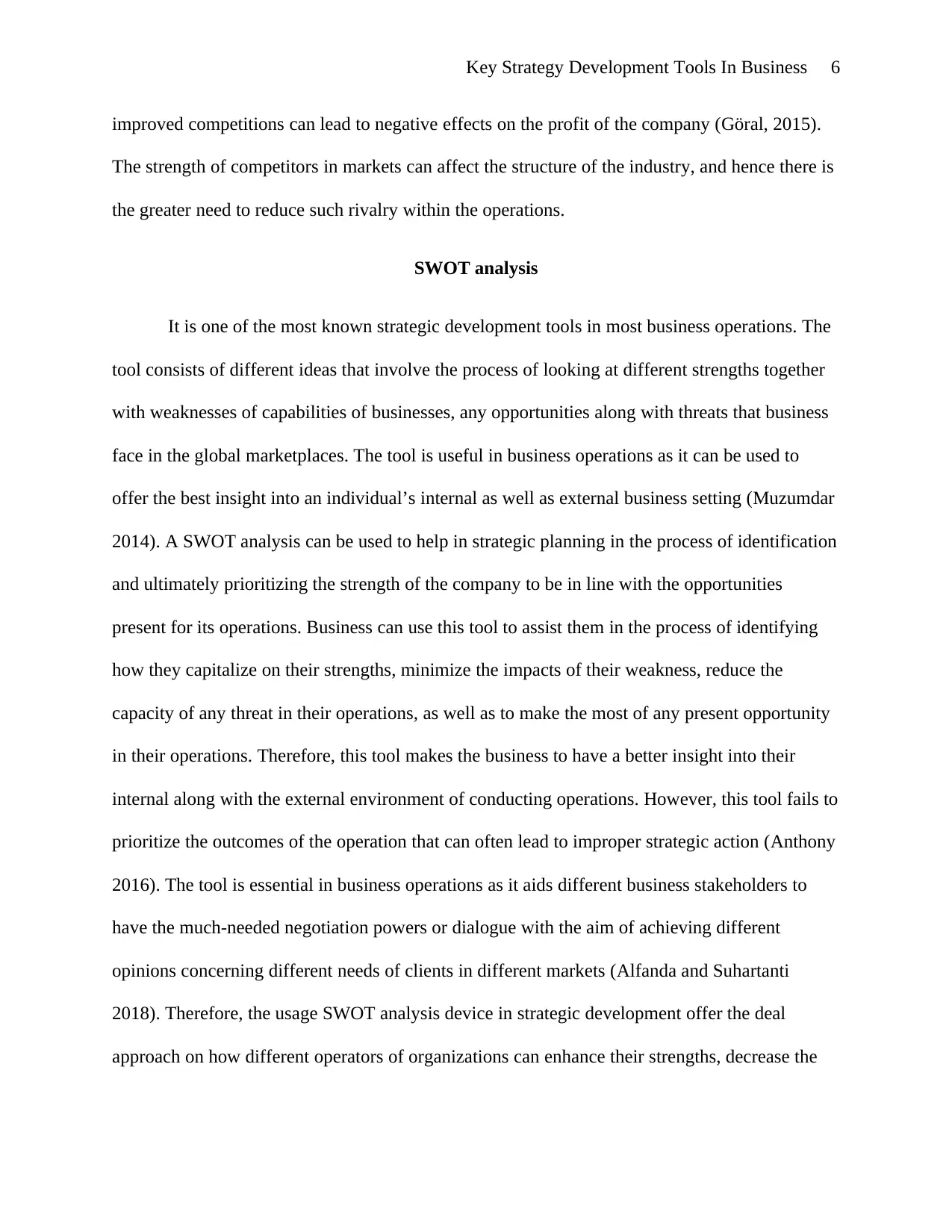
Key Strategy Development Tools In Business 6
improved competitions can lead to negative effects on the profit of the company (Göral, 2015).
The strength of competitors in markets can affect the structure of the industry, and hence there is
the greater need to reduce such rivalry within the operations.
SWOT analysis
It is one of the most known strategic development tools in most business operations. The
tool consists of different ideas that involve the process of looking at different strengths together
with weaknesses of capabilities of businesses, any opportunities along with threats that business
face in the global marketplaces. The tool is useful in business operations as it can be used to
offer the best insight into an individual’s internal as well as external business setting (Muzumdar
2014). A SWOT analysis can be used to help in strategic planning in the process of identification
and ultimately prioritizing the strength of the company to be in line with the opportunities
present for its operations. Business can use this tool to assist them in the process of identifying
how they capitalize on their strengths, minimize the impacts of their weakness, reduce the
capacity of any threat in their operations, as well as to make the most of any present opportunity
in their operations. Therefore, this tool makes the business to have a better insight into their
internal along with the external environment of conducting operations. However, this tool fails to
prioritize the outcomes of the operation that can often lead to improper strategic action (Anthony
2016). The tool is essential in business operations as it aids different business stakeholders to
have the much-needed negotiation powers or dialogue with the aim of achieving different
opinions concerning different needs of clients in different markets (Alfanda and Suhartanti
2018). Therefore, the usage SWOT analysis device in strategic development offer the deal
approach on how different operators of organizations can enhance their strengths, decrease the
improved competitions can lead to negative effects on the profit of the company (Göral, 2015).
The strength of competitors in markets can affect the structure of the industry, and hence there is
the greater need to reduce such rivalry within the operations.
SWOT analysis
It is one of the most known strategic development tools in most business operations. The
tool consists of different ideas that involve the process of looking at different strengths together
with weaknesses of capabilities of businesses, any opportunities along with threats that business
face in the global marketplaces. The tool is useful in business operations as it can be used to
offer the best insight into an individual’s internal as well as external business setting (Muzumdar
2014). A SWOT analysis can be used to help in strategic planning in the process of identification
and ultimately prioritizing the strength of the company to be in line with the opportunities
present for its operations. Business can use this tool to assist them in the process of identifying
how they capitalize on their strengths, minimize the impacts of their weakness, reduce the
capacity of any threat in their operations, as well as to make the most of any present opportunity
in their operations. Therefore, this tool makes the business to have a better insight into their
internal along with the external environment of conducting operations. However, this tool fails to
prioritize the outcomes of the operation that can often lead to improper strategic action (Anthony
2016). The tool is essential in business operations as it aids different business stakeholders to
have the much-needed negotiation powers or dialogue with the aim of achieving different
opinions concerning different needs of clients in different markets (Alfanda and Suhartanti
2018). Therefore, the usage SWOT analysis device in strategic development offer the deal
approach on how different operators of organizations can enhance their strengths, decrease the
⊘ This is a preview!⊘
Do you want full access?
Subscribe today to unlock all pages.

Trusted by 1+ million students worldwide
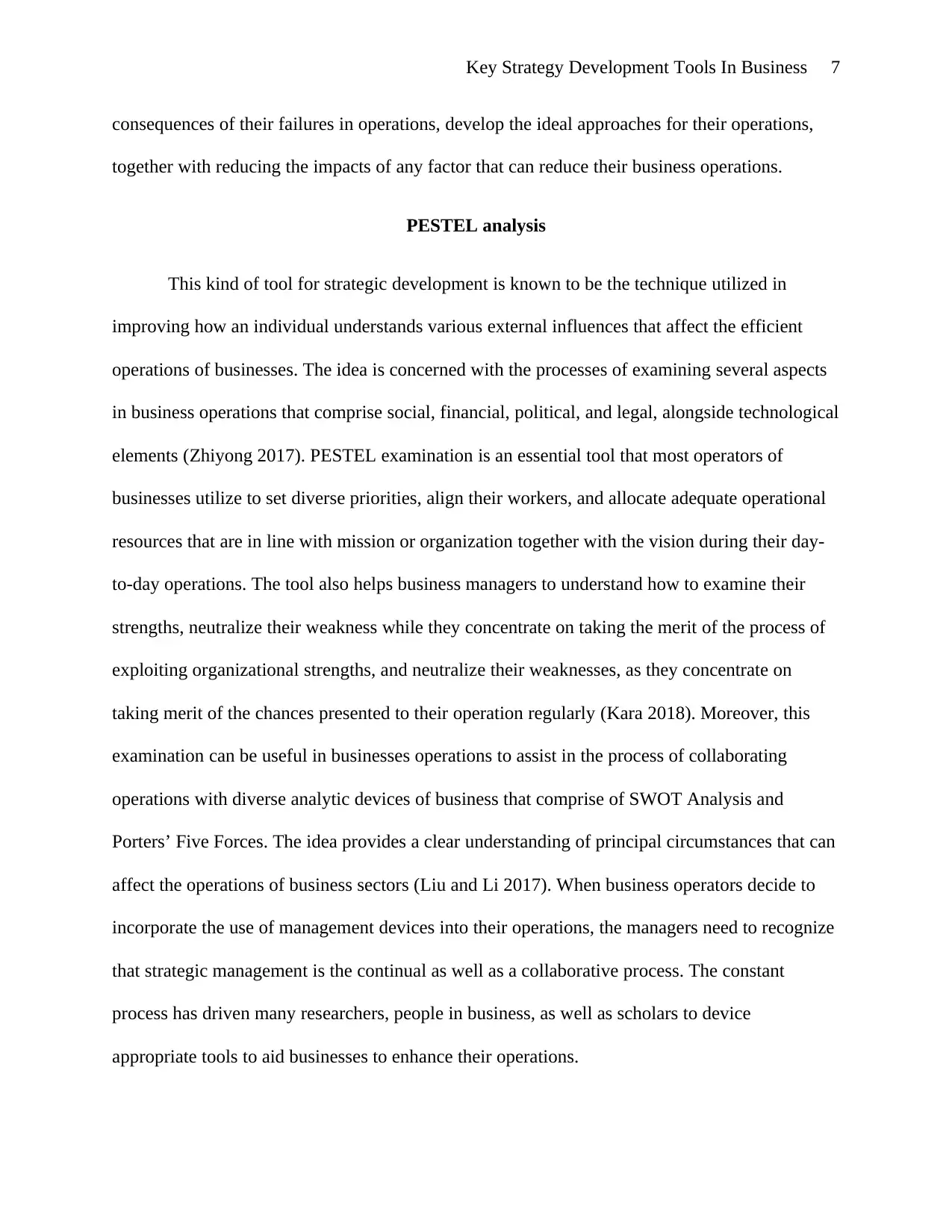
Key Strategy Development Tools In Business 7
consequences of their failures in operations, develop the ideal approaches for their operations,
together with reducing the impacts of any factor that can reduce their business operations.
PESTEL analysis
This kind of tool for strategic development is known to be the technique utilized in
improving how an individual understands various external influences that affect the efficient
operations of businesses. The idea is concerned with the processes of examining several aspects
in business operations that comprise social, financial, political, and legal, alongside technological
elements (Zhiyong 2017). PESTEL examination is an essential tool that most operators of
businesses utilize to set diverse priorities, align their workers, and allocate adequate operational
resources that are in line with mission or organization together with the vision during their day-
to-day operations. The tool also helps business managers to understand how to examine their
strengths, neutralize their weakness while they concentrate on taking the merit of the process of
exploiting organizational strengths, and neutralize their weaknesses, as they concentrate on
taking merit of the chances presented to their operation regularly (Kara 2018). Moreover, this
examination can be useful in businesses operations to assist in the process of collaborating
operations with diverse analytic devices of business that comprise of SWOT Analysis and
Porters’ Five Forces. The idea provides a clear understanding of principal circumstances that can
affect the operations of business sectors (Liu and Li 2017). When business operators decide to
incorporate the use of management devices into their operations, the managers need to recognize
that strategic management is the continual as well as a collaborative process. The constant
process has driven many researchers, people in business, as well as scholars to device
appropriate tools to aid businesses to enhance their operations.
consequences of their failures in operations, develop the ideal approaches for their operations,
together with reducing the impacts of any factor that can reduce their business operations.
PESTEL analysis
This kind of tool for strategic development is known to be the technique utilized in
improving how an individual understands various external influences that affect the efficient
operations of businesses. The idea is concerned with the processes of examining several aspects
in business operations that comprise social, financial, political, and legal, alongside technological
elements (Zhiyong 2017). PESTEL examination is an essential tool that most operators of
businesses utilize to set diverse priorities, align their workers, and allocate adequate operational
resources that are in line with mission or organization together with the vision during their day-
to-day operations. The tool also helps business managers to understand how to examine their
strengths, neutralize their weakness while they concentrate on taking the merit of the process of
exploiting organizational strengths, and neutralize their weaknesses, as they concentrate on
taking merit of the chances presented to their operation regularly (Kara 2018). Moreover, this
examination can be useful in businesses operations to assist in the process of collaborating
operations with diverse analytic devices of business that comprise of SWOT Analysis and
Porters’ Five Forces. The idea provides a clear understanding of principal circumstances that can
affect the operations of business sectors (Liu and Li 2017). When business operators decide to
incorporate the use of management devices into their operations, the managers need to recognize
that strategic management is the continual as well as a collaborative process. The constant
process has driven many researchers, people in business, as well as scholars to device
appropriate tools to aid businesses to enhance their operations.
Paraphrase This Document
Need a fresh take? Get an instant paraphrase of this document with our AI Paraphraser
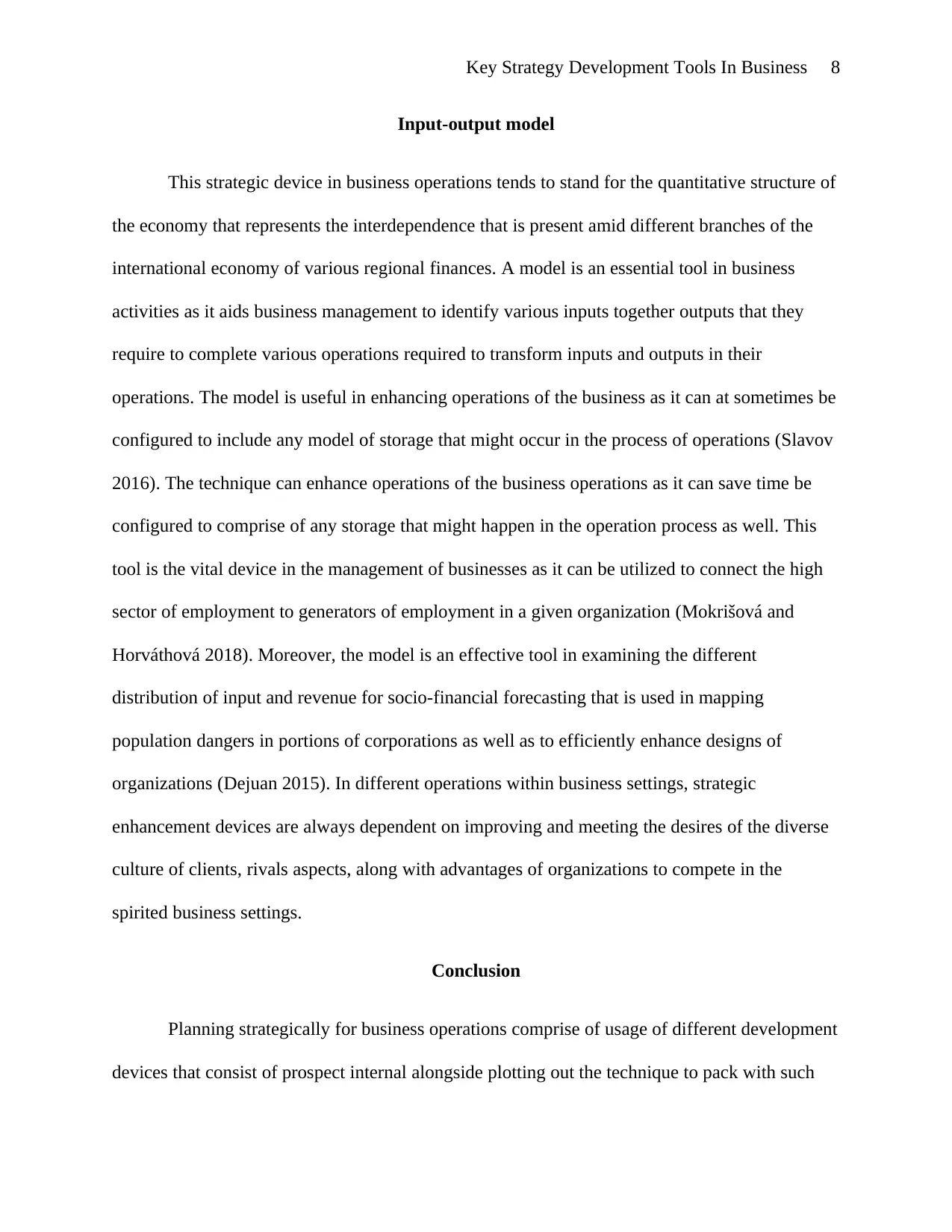
Key Strategy Development Tools In Business 8
Input-output model
This strategic device in business operations tends to stand for the quantitative structure of
the economy that represents the interdependence that is present amid different branches of the
international economy of various regional finances. A model is an essential tool in business
activities as it aids business management to identify various inputs together outputs that they
require to complete various operations required to transform inputs and outputs in their
operations. The model is useful in enhancing operations of the business as it can at sometimes be
configured to include any model of storage that might occur in the process of operations (Slavov
2016). The technique can enhance operations of the business operations as it can save time be
configured to comprise of any storage that might happen in the operation process as well. This
tool is the vital device in the management of businesses as it can be utilized to connect the high
sector of employment to generators of employment in a given organization (Mokrišová and
Horváthová 2018). Moreover, the model is an effective tool in examining the different
distribution of input and revenue for socio-financial forecasting that is used in mapping
population dangers in portions of corporations as well as to efficiently enhance designs of
organizations (Dejuan 2015). In different operations within business settings, strategic
enhancement devices are always dependent on improving and meeting the desires of the diverse
culture of clients, rivals aspects, along with advantages of organizations to compete in the
spirited business settings.
Conclusion
Planning strategically for business operations comprise of usage of different development
devices that consist of prospect internal alongside plotting out the technique to pack with such
Input-output model
This strategic device in business operations tends to stand for the quantitative structure of
the economy that represents the interdependence that is present amid different branches of the
international economy of various regional finances. A model is an essential tool in business
activities as it aids business management to identify various inputs together outputs that they
require to complete various operations required to transform inputs and outputs in their
operations. The model is useful in enhancing operations of the business as it can at sometimes be
configured to include any model of storage that might occur in the process of operations (Slavov
2016). The technique can enhance operations of the business operations as it can save time be
configured to comprise of any storage that might happen in the operation process as well. This
tool is the vital device in the management of businesses as it can be utilized to connect the high
sector of employment to generators of employment in a given organization (Mokrišová and
Horváthová 2018). Moreover, the model is an effective tool in examining the different
distribution of input and revenue for socio-financial forecasting that is used in mapping
population dangers in portions of corporations as well as to efficiently enhance designs of
organizations (Dejuan 2015). In different operations within business settings, strategic
enhancement devices are always dependent on improving and meeting the desires of the diverse
culture of clients, rivals aspects, along with advantages of organizations to compete in the
spirited business settings.
Conclusion
Planning strategically for business operations comprise of usage of different development
devices that consist of prospect internal alongside plotting out the technique to pack with such
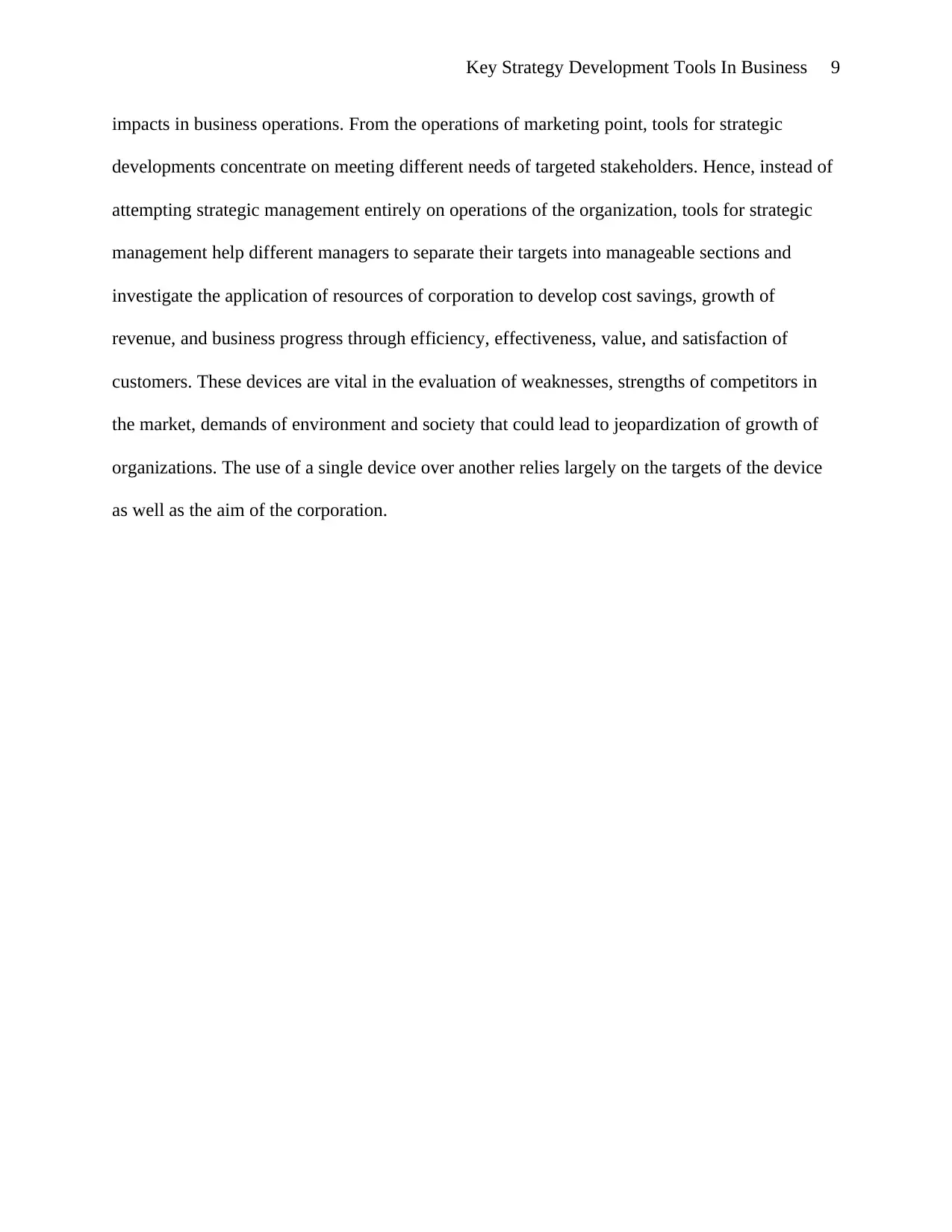
Key Strategy Development Tools In Business 9
impacts in business operations. From the operations of marketing point, tools for strategic
developments concentrate on meeting different needs of targeted stakeholders. Hence, instead of
attempting strategic management entirely on operations of the organization, tools for strategic
management help different managers to separate their targets into manageable sections and
investigate the application of resources of corporation to develop cost savings, growth of
revenue, and business progress through efficiency, effectiveness, value, and satisfaction of
customers. These devices are vital in the evaluation of weaknesses, strengths of competitors in
the market, demands of environment and society that could lead to jeopardization of growth of
organizations. The use of a single device over another relies largely on the targets of the device
as well as the aim of the corporation.
impacts in business operations. From the operations of marketing point, tools for strategic
developments concentrate on meeting different needs of targeted stakeholders. Hence, instead of
attempting strategic management entirely on operations of the organization, tools for strategic
management help different managers to separate their targets into manageable sections and
investigate the application of resources of corporation to develop cost savings, growth of
revenue, and business progress through efficiency, effectiveness, value, and satisfaction of
customers. These devices are vital in the evaluation of weaknesses, strengths of competitors in
the market, demands of environment and society that could lead to jeopardization of growth of
organizations. The use of a single device over another relies largely on the targets of the device
as well as the aim of the corporation.
⊘ This is a preview!⊘
Do you want full access?
Subscribe today to unlock all pages.

Trusted by 1+ million students worldwide
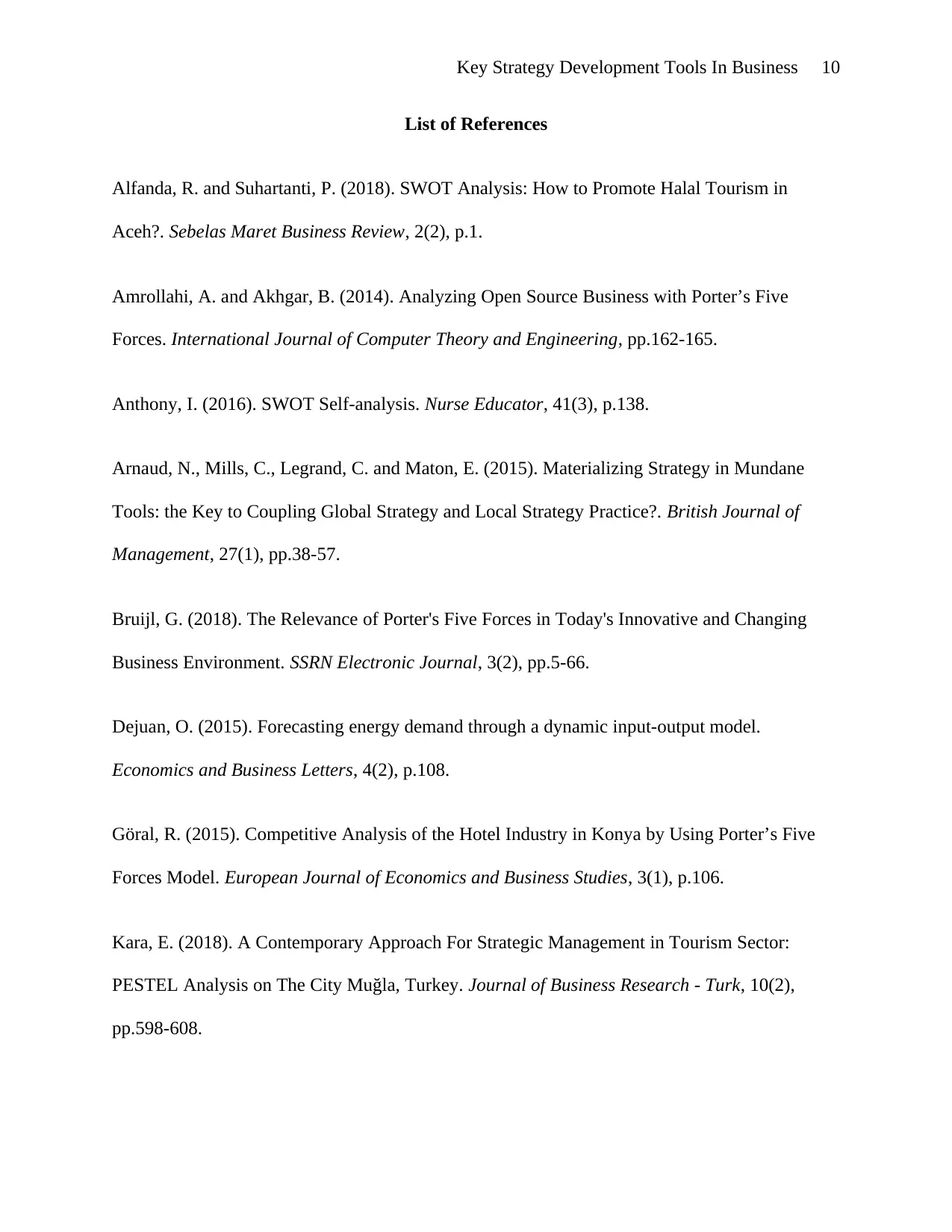
Key Strategy Development Tools In Business 10
List of References
Alfanda, R. and Suhartanti, P. (2018). SWOT Analysis: How to Promote Halal Tourism in
Aceh?. Sebelas Maret Business Review, 2(2), p.1.
Amrollahi, A. and Akhgar, B. (2014). Analyzing Open Source Business with Porter’s Five
Forces. International Journal of Computer Theory and Engineering, pp.162-165.
Anthony, I. (2016). SWOT Self-analysis. Nurse Educator, 41(3), p.138.
Arnaud, N., Mills, C., Legrand, C. and Maton, E. (2015). Materializing Strategy in Mundane
Tools: the Key to Coupling Global Strategy and Local Strategy Practice?. British Journal of
Management, 27(1), pp.38-57.
Bruijl, G. (2018). The Relevance of Porter's Five Forces in Today's Innovative and Changing
Business Environment. SSRN Electronic Journal, 3(2), pp.5-66.
Dejuan, O. (2015). Forecasting energy demand through a dynamic input-output model.
Economics and Business Letters, 4(2), p.108.
Göral, R. (2015). Competitive Analysis of the Hotel Industry in Konya by Using Porter’s Five
Forces Model. European Journal of Economics and Business Studies, 3(1), p.106.
Kara, E. (2018). A Contemporary Approach For Strategic Management in Tourism Sector:
PESTEL Analysis on The City Muğla, Turkey. Journal of Business Research - Turk, 10(2),
pp.598-608.
List of References
Alfanda, R. and Suhartanti, P. (2018). SWOT Analysis: How to Promote Halal Tourism in
Aceh?. Sebelas Maret Business Review, 2(2), p.1.
Amrollahi, A. and Akhgar, B. (2014). Analyzing Open Source Business with Porter’s Five
Forces. International Journal of Computer Theory and Engineering, pp.162-165.
Anthony, I. (2016). SWOT Self-analysis. Nurse Educator, 41(3), p.138.
Arnaud, N., Mills, C., Legrand, C. and Maton, E. (2015). Materializing Strategy in Mundane
Tools: the Key to Coupling Global Strategy and Local Strategy Practice?. British Journal of
Management, 27(1), pp.38-57.
Bruijl, G. (2018). The Relevance of Porter's Five Forces in Today's Innovative and Changing
Business Environment. SSRN Electronic Journal, 3(2), pp.5-66.
Dejuan, O. (2015). Forecasting energy demand through a dynamic input-output model.
Economics and Business Letters, 4(2), p.108.
Göral, R. (2015). Competitive Analysis of the Hotel Industry in Konya by Using Porter’s Five
Forces Model. European Journal of Economics and Business Studies, 3(1), p.106.
Kara, E. (2018). A Contemporary Approach For Strategic Management in Tourism Sector:
PESTEL Analysis on The City Muğla, Turkey. Journal of Business Research - Turk, 10(2),
pp.598-608.
Paraphrase This Document
Need a fresh take? Get an instant paraphrase of this document with our AI Paraphraser
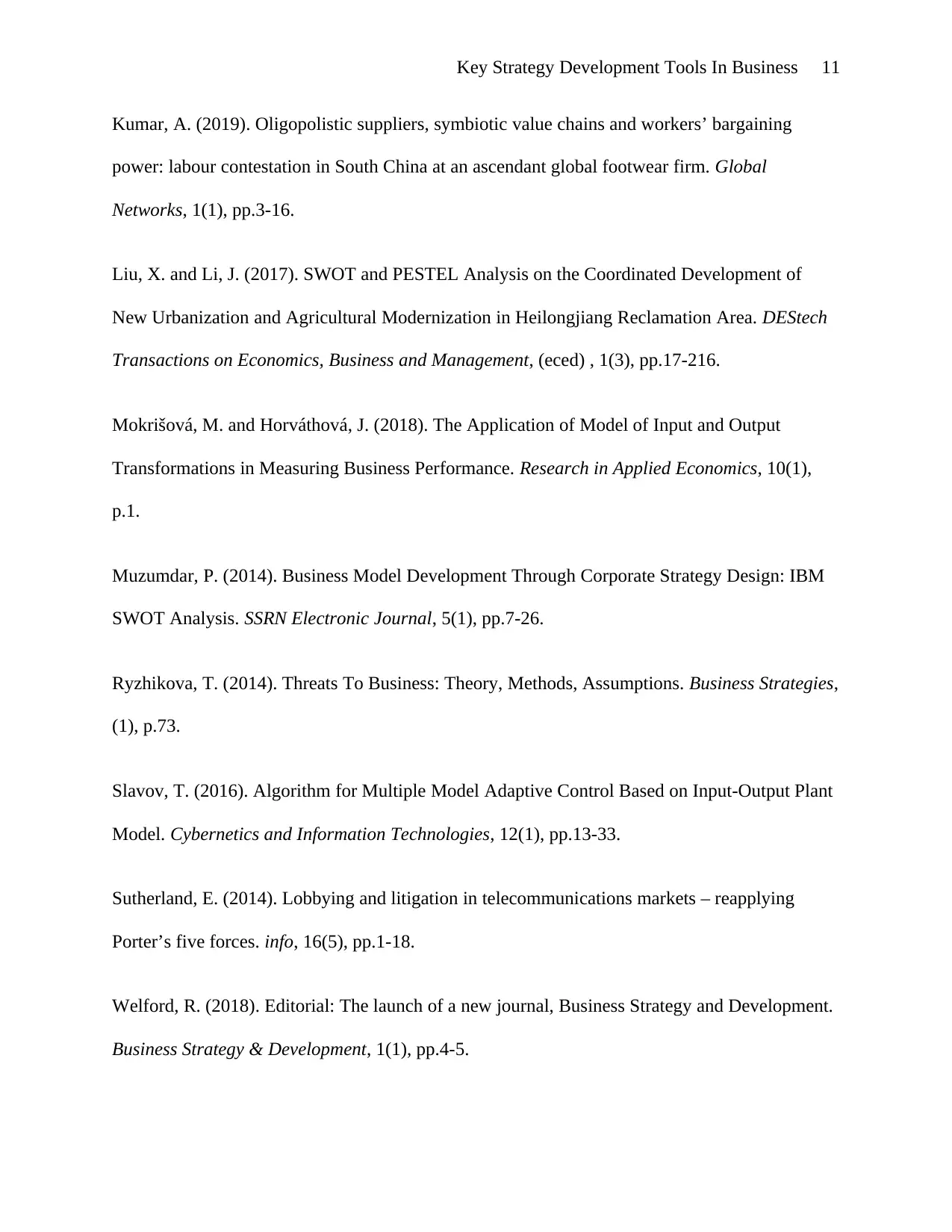
Key Strategy Development Tools In Business 11
Kumar, A. (2019). Oligopolistic suppliers, symbiotic value chains and workers’ bargaining
power: labour contestation in South China at an ascendant global footwear firm. Global
Networks, 1(1), pp.3-16.
Liu, X. and Li, J. (2017). SWOT and PESTEL Analysis on the Coordinated Development of
New Urbanization and Agricultural Modernization in Heilongjiang Reclamation Area. DEStech
Transactions on Economics, Business and Management, (eced) , 1(3), pp.17-216.
Mokrišová, M. and Horváthová, J. (2018). The Application of Model of Input and Output
Transformations in Measuring Business Performance. Research in Applied Economics, 10(1),
p.1.
Muzumdar, P. (2014). Business Model Development Through Corporate Strategy Design: IBM
SWOT Analysis. SSRN Electronic Journal, 5(1), pp.7-26.
Ryzhikova, T. (2014). Threats To Business: Theory, Methods, Assumptions. Business Strategies,
(1), p.73.
Slavov, T. (2016). Algorithm for Multiple Model Adaptive Control Based on Input-Output Plant
Model. Cybernetics and Information Technologies, 12(1), pp.13-33.
Sutherland, E. (2014). Lobbying and litigation in telecommunications markets – reapplying
Porter’s five forces. info, 16(5), pp.1-18.
Welford, R. (2018). Editorial: The launch of a new journal, Business Strategy and Development.
Business Strategy & Development, 1(1), pp.4-5.
Kumar, A. (2019). Oligopolistic suppliers, symbiotic value chains and workers’ bargaining
power: labour contestation in South China at an ascendant global footwear firm. Global
Networks, 1(1), pp.3-16.
Liu, X. and Li, J. (2017). SWOT and PESTEL Analysis on the Coordinated Development of
New Urbanization and Agricultural Modernization in Heilongjiang Reclamation Area. DEStech
Transactions on Economics, Business and Management, (eced) , 1(3), pp.17-216.
Mokrišová, M. and Horváthová, J. (2018). The Application of Model of Input and Output
Transformations in Measuring Business Performance. Research in Applied Economics, 10(1),
p.1.
Muzumdar, P. (2014). Business Model Development Through Corporate Strategy Design: IBM
SWOT Analysis. SSRN Electronic Journal, 5(1), pp.7-26.
Ryzhikova, T. (2014). Threats To Business: Theory, Methods, Assumptions. Business Strategies,
(1), p.73.
Slavov, T. (2016). Algorithm for Multiple Model Adaptive Control Based on Input-Output Plant
Model. Cybernetics and Information Technologies, 12(1), pp.13-33.
Sutherland, E. (2014). Lobbying and litigation in telecommunications markets – reapplying
Porter’s five forces. info, 16(5), pp.1-18.
Welford, R. (2018). Editorial: The launch of a new journal, Business Strategy and Development.
Business Strategy & Development, 1(1), pp.4-5.
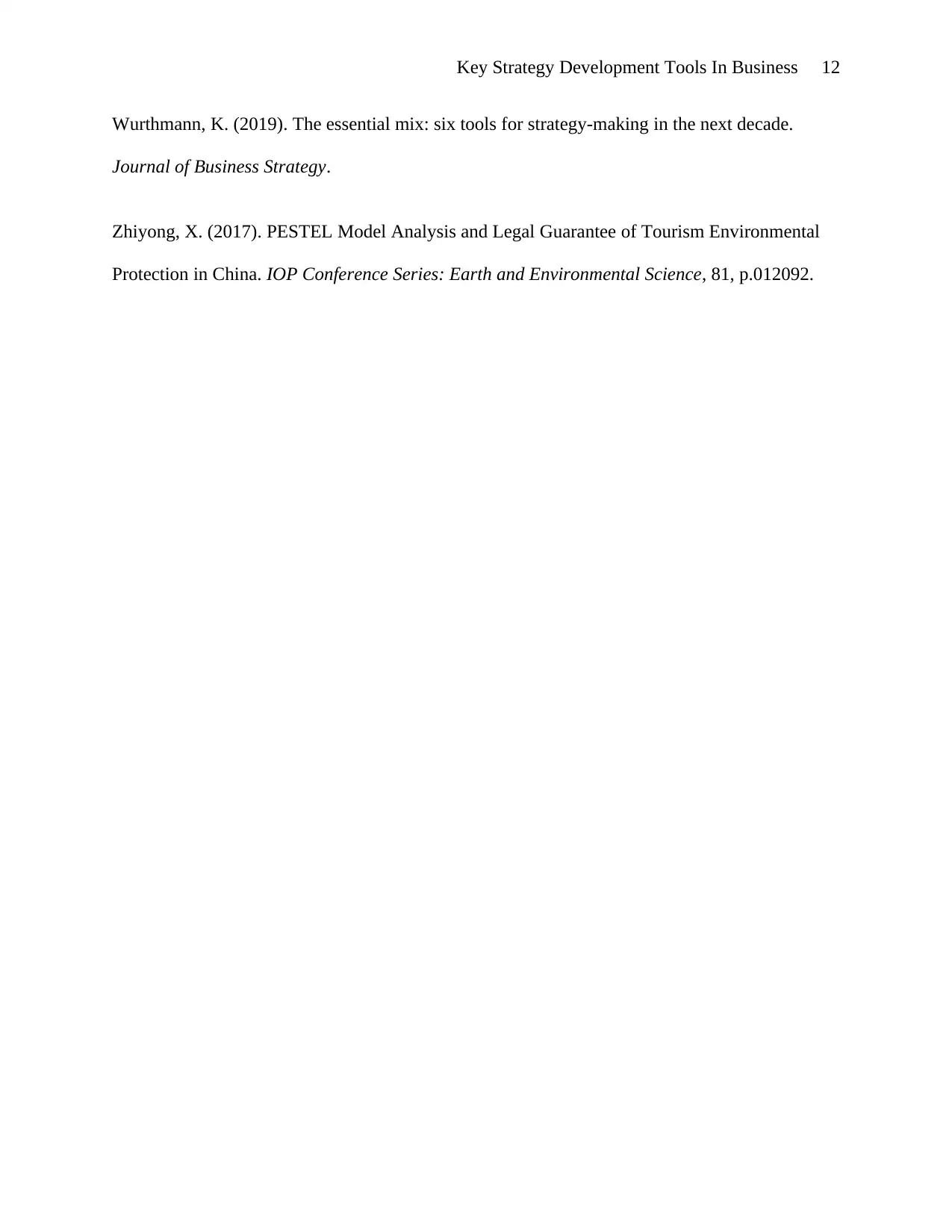
Key Strategy Development Tools In Business 12
Wurthmann, K. (2019). The essential mix: six tools for strategy-making in the next decade.
Journal of Business Strategy.
Zhiyong, X. (2017). PESTEL Model Analysis and Legal Guarantee of Tourism Environmental
Protection in China. IOP Conference Series: Earth and Environmental Science, 81, p.012092.
Wurthmann, K. (2019). The essential mix: six tools for strategy-making in the next decade.
Journal of Business Strategy.
Zhiyong, X. (2017). PESTEL Model Analysis and Legal Guarantee of Tourism Environmental
Protection in China. IOP Conference Series: Earth and Environmental Science, 81, p.012092.
⊘ This is a preview!⊘
Do you want full access?
Subscribe today to unlock all pages.

Trusted by 1+ million students worldwide
1 out of 12
Related Documents
Your All-in-One AI-Powered Toolkit for Academic Success.
+13062052269
info@desklib.com
Available 24*7 on WhatsApp / Email
![[object Object]](/_next/static/media/star-bottom.7253800d.svg)
Unlock your academic potential
Copyright © 2020–2025 A2Z Services. All Rights Reserved. Developed and managed by ZUCOL.





